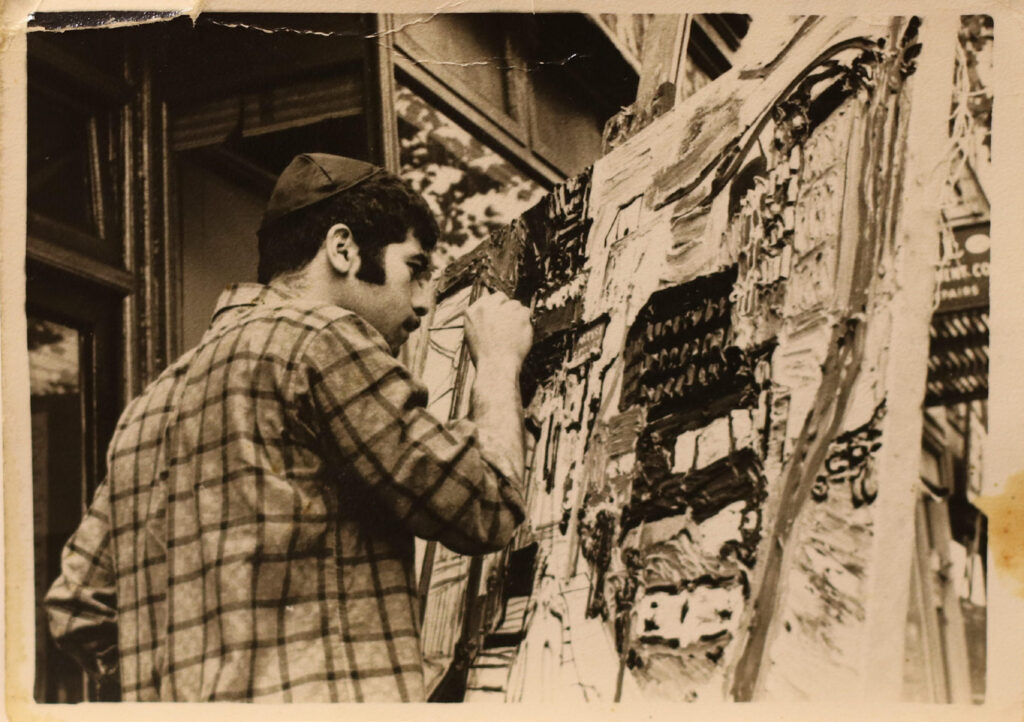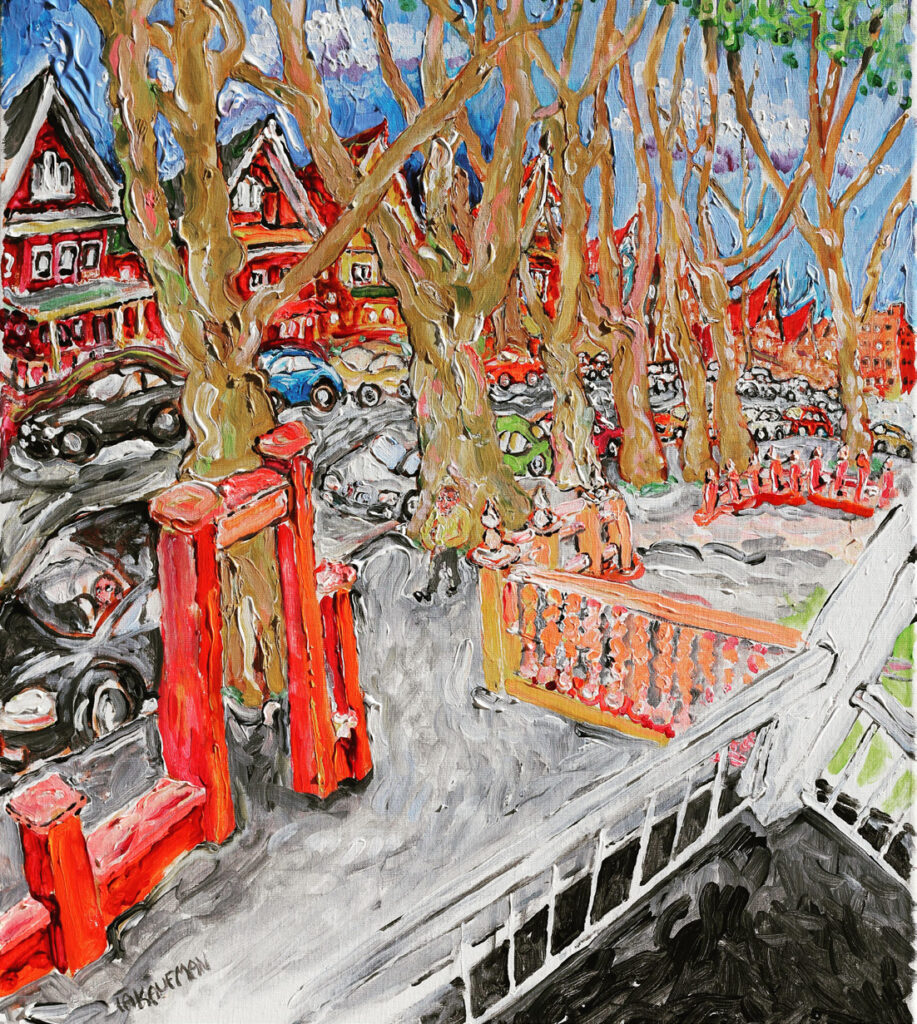
Ira Kaufman launched his art career as a figurative expressionist painter at the height of the 10th Street Galleries of the 1960s in New York. However, unlike many of his contemporaries who set out to counter the earlier abstract expressionist movement, record social and political causes, Kaufman has painted his own unique and personal visions of humanity.
He sees art as a semi-religious venture and feels that artists need to be honest and unique.
Kaufman is not only religious as an artist, but he is also a Breslaver Chasid, a faith that believes in serving God with the sincerity of the heart, with much joy, and living life as intensely as possible. This is evident in his paintings and drawings which are also inspired by the streets of Brooklyn, New York, the towns and countryside of Israel where he has lived, and by the many stories found in the Torah.
Family Background
He was born in 1943 and grew up in Bensonhurst, Brooklyn. His parents were Dora and Jack Kaufman, both originally from Belarus. Dora was a manager at a “zipper hospital”, and sadly died from leukemia when her son was only seven. Jack was a letter carrier who died from heart problems when Ira was seventeen. He delivered mail to the arts’ district of Chelsea and Kaufman theorizes that the art talent was transferred to him from the mail. After his father’s death, he lived with his Aunt Ann who was a hobby painter and encouraged his artistic desire and talent, taking him often to art museums. However, she thought he should also be practical and go into commercial art. This ran counter to Kaufman’s instinct.
Kaufman took little interest in school and would draw all day. He later enrolled in the School of Visual Arts. After graduating he got married at 19 and went to work as a handyman. However, all his free time was spent painting. He bought high quality paints and turned his living room into a studio. When it came to the point where Ira was happy with his work, he decided to look for an outlet to display and sell his paintings.
10th Street Galleries
On Sundays, Kaufman would canvas the city to look for the right venue. He found the 10th Street Galleries in Greenwich Village, New York to fit the bill. He applied to and was rejected by each gallery. He left the Brata Gallery for last, considering it to be the best. Brata was an artists’ cooperative gallery started by the Krushenick brothers. There Kaufman was finally accepted.
“John Krushenick was ecstatic that I was in by one vote. I was too young to appreciate the concept and value of controversy at the time.”
Kaufman was not so aware of the various art movements at that time but gravitated towards figurative expressionism and has since remained in that sphere. Artists at the Brata Gallery had one solo show per year and Kaufman had his first in 1965. He was shocked that his art sold. His work was favorably reviewed by Ted Berrigan of ARTnews. “…a hip primitive with two eyes for color. His large assertive canvases acknowledge, Munch, Cézanne and Rousseau while boldly stating à la Henry Miller, ‘I’m from Brooklyn!’ ” Another solo show the following year was reviewed by Peter Schjeldahl of ARTnews. “…Best is his Pan-goat in a meadow by a stream, the paint slapped, slashed, sloshed like a gorgeous and heroic paean to anything you like.”

Kaufman also went on to show with Allan Stone Gallery, and with John Hoffa, one of the founding members of the Rhino Horn group. He also became the Brata Proprietor/Gallery Director, (although he doesn’t think he had such a fancy title), using the middle of the gallery space as a studio and showing the member’s art when a customer walked in.
In 1970 Kaufman took his family to Israel. He had two small children at that time and felt New York was not the place for them. Elaine De Kooning who had a studio around the corner from the Brata told him that Israel was really where they all wanted to be.
Arriving in Israel, the art scene was not as established as in New York and Kaufman had to support his family. He found that his love of Alfa Romeos and the skills he had to maintain them translated to a good job as a car mechanic. Kaufman is not the only talented artist to work at a side job. Rothko worked as an elementary school teacher, Rousseau as a tax collector and Jackson Pollack as a babysitter so he was in good company. He could have been a success in business; however, his primary goal has always been to be successful as an artist and he has relentlessly followed that path.
His Vision
Ira doesn’t see himself as a follower of one genre. He likes to see his works as true to himself. The art critic and painter John Graham asks in his seminal work, System and Dialectics of Art, “why does an artist create?” Graham answers “out of a feeling of suffering.” In Kaufman’s case, this relates directly to his early loss of his parents and consequent nostalgia.

However, humor is an intrinsic part of Kaufman and his art. He likes to joke and tell involved funny stories which display his wit. In fact, he once considered working at The Comedy Club in New York, but his wife put a stop to that! His paintings all have a degree of humor, anywhere from a hint to guffaw.
Asked about his vision as an artist Kaufman responds, “To infer I’m continuing [in] a particular way, trend, intent, or theory would be false. The cave wall painters at Lascaux painted what burned within…a million particulars which occupied their intellect. I desire such in my paintings. If I’ve conveyed myself, [then] I’ve truly painted. I paint figurative expressionism, but that’s just a round hole to fit a round peg…. What do I want in my painting? To be a true brother to the artist who painted the walls at Lascaux.” G&S
Ira Kaufman’s art may also be found at hemleygallery.com





Beautiful article! Ira Kaufman is a legend!